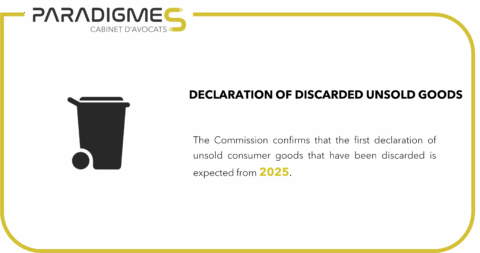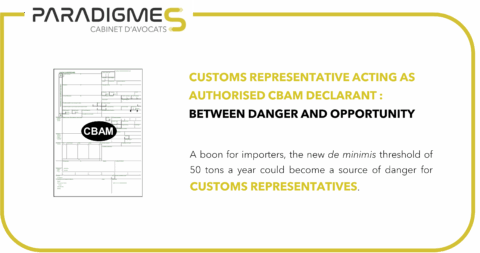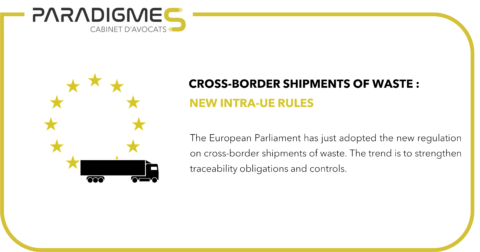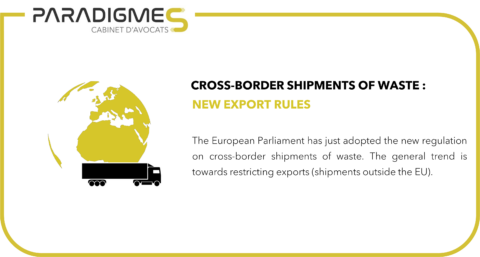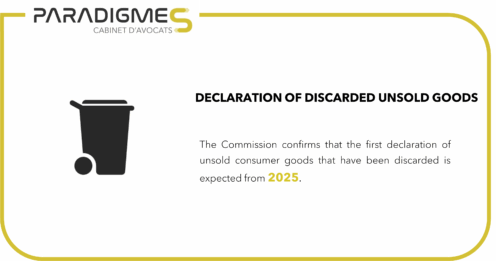
by Evguénia DEREVIANKINE | 16 Oct, 2025 | News
Article 24 of Regulation 2024/1781 of 13 June 2024, known as ESPR, introduced the obligation for manufacturers and distributors of consumer goods to report their discarded unsold goods.
The Commission has just confirmed, in the latest version of the draft implementing regulation to be published, that the first declaration is expected for the year 2025, to be published during 2026.
As the reporting format proposed in the draft is not yet mandatory, the declaration for 2025 will have to be made in a free format. However, it must identify the main categories of products destined for waste treatment, the reasons for this choice, the treatment channels selected, the number of units concerned and the preventive measures taken. All unsold consumer products that are discarded must be declared, not just those listed in Annex II of the draft implementing regulation.
The declaration must be made on the operator’s website and remain accessible there for five years.
In subsequent years, and at the latest from 2027 onwards, products must be identified by HS customs code (the first four digits for products listed in Annex II of the draft implementing regulation and the first two digits for other products) and declared in the format set out in Annex I of the draft implementing regulation, which is due to be published in the coming days.
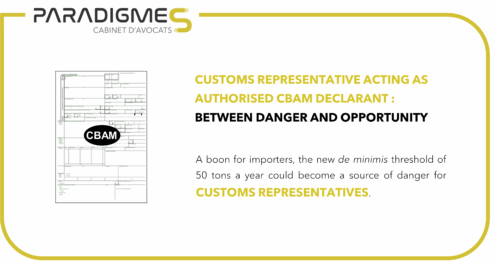
by Evguénia DEREVIANKINE | 18 Sep, 2025 | News
On 10 September 2025, the European Parliament gave the green light to the changes to the Carbon Border Adjustment Mechanism (CBAM) agreed as part of the Omnibus I simplification package.
From now on, importers established in the EU whose expected imports of goods falling within the scope of the CBAM do not exceed 50 tons of net mass per calendar year will be able to continue importing without additional constraints. They will only have to obtain authorised CBAM declarant status and comply with the obligations laid down in Regulation (EU) 2023/956 (CBAM declarations, purchase and exchange of CBAM certificates, etc.) if their import forecasts exceed this new de minimis threshold, also during the year in question.
As for importers not established in the EU, they will not be able to import goods falling within the scope of the CBAM, unless they use a customs representative acting as an indirect representative and agreeing to be their authorised CBAM declarant, even if their imports are exempt from the CBAM because they do not exceed the de minimis threshold of 50 tons per year.
While the new de minimis threshold is a boon for importers, it will become a source of danger for customs representatives who choose to offer authorised CBAM declarant services. The application of the CBAM to almost all imports (i.e. to every shipment with a value exceeding €150, the former de minimis threshold) had the advantage of encouraging operators to be cautious, forcing them to use the services of professionals specialising in emissions calculation, whose involvement was a guarantee of the reliability of the data provided to customs representatives. This guarantee will no longer apply when importers instruct customs representatives to clear goods under the de minimis exemption. A customs representative unfamiliar with the subject may consider that using the de minimis exemption is a risk-free operation, but he or she would be wrong: no one can guarantee that this exemption will not be challenged at a later stage, either because the importer has exceeded the de minimis threshold during the year in question, or because the importer has attempted to circumvent the system (by cheating on the declared weight, splitting imports and using front men, etc.). The customs representative acting as the authorised CBAM declarant will then be the only person on the front line, as the regulation now expressly states that “where an indirect customs representative acts as an authorised CBAM declarant on behalf of an importer, the indirect customs representative should be subject to the obligations applicable to that importer pursuant to Regulation (EU) 2023/956, in particular the obligation to submit a CBAM declaration in respect of the goods imported by the indirect customs representative on behalf of that importer and to surrender the CBAM certificates in respect of emissions embedded in those goods. As a result, in the event of non-compliance, it should be the indirect customs representative that is subject to penalties under Regulation (EU) 2023/956” (recital 8 of the draft amending regulation).
Customs representatives who choose to assist their clients in managing the CBAM will need to pay particular attention to the contractual aspects of their offer and think carefully about the best way to cover the relevant risks.
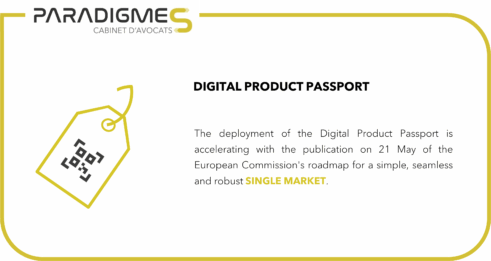
by Evguénia DEREVIANKINE | 23 May, 2025 | News
Launched in 2022, the Digital Product Passport (DPP) deployment project is accelerating with the publication on 21 May of the European Commission’s roadmap for a simple, seamless and robust single market.
A response to regulatory and environmental challenges
Introduced into European regulations to provide a solution to the issue of the proliferation of regulations requiring the display of information on the composition, traceability and end-of-life management of products, the Digital Product Passport consists of compiling and making available – using user-friendly technology (QR codes) – all relevant information:
- to end users, enabling themin making informed consumption choices;
- to other actors in the value chain who interact with the product, such as manufacturers, agents, importers, distributors, retailers, order fulfilment service providers, repairers, reconditioners, recyclers, etc.;
- or to administrations responsible for market surveillance and control, such as customs authorities.
The Digital Product Passport has already been incorporated into the following regulations:
- Regulation (EU) 2023/1542 on batteries and battery waste (application of the provisions relating to the Passport from 18 February 2027);
- Regulation (EU) 2024/1781 establishing a framework for the setting of eco-design requirements for sustainable products (provisions relating to the Passport pending a delegated act to be adopted after 19 July 2025);
- Regulation (EU) 2024/3110 laying down rules on the marketing of construction products (text applicable from 8 January 2026 and provisions relating to the Passport pending clarification by delegated act);
- Regulation (EU) 2024/1834 laying down ecodesign requirements for fans (text applicable from 24 July 2026 and a review clause provides for the potential introduction of the Passport);
- Directive (EU) 2024/1799 on promoting the repair of goods (text to be transposed by 31 July 2026 at the latest, but the Passport remains an optional means of transmitting information);
- Regulation (EU) 2025/40 on packaging and packaging waste (applicable from 12 August 2026 and referring to Regulation (EU) 2024/1781 for the inclusion of packaging information in the Product Passport).
It will soon be extended to other similar types of information and will eventually replace all types of labelling, except for essential information that must remain visible on the packaging (safety instructions, etc.). The next project announced by the Commission concerns the introduction of the Digital Product Passport in the textile industry as part of its Strategy for a Sustainable and Circular Textile Industry.
In addition, the Digital Product Passport aims to harmonise display and labelling standards, which still vary to some extent between Member States, requiring marketers to adapt their products to each national market.
Conclusive experiment
The CIRPASS project, launched in October 2022 and completed in March 2024, was tasked with structuring the Digital Product Passport. It laid the conceptual foundations for the Passport and identified the standards, protocols and data models necessary to make it an interoperable, secure and scalable tool.
Its successor, CIRPASS-2, launched in May 2024 for a period of three years, aims to test the Passport’s operation in a real industrial environment through 13 pilot projects covering four value chains:
- Textiles
- Electrical and electronic equipment
- Tyres
- Construction materials
The project also aims to facilitate the rollout of the Passport to make it accessible to small and medium-sized enterprises (SMEs).
A widespread and interconnected infrastructure
The European Commission’s ambition is to make the Digital Product Passport the common digital infrastructure for all European industrial sectors by:
- standardising machine-readable data formats,
- ensuring interoperability between sectors and between Member States,
- creating a European product data ecosystem, including the management of non-mandatory data.
The data in the Digital Product Passport can also be cross-referenced with other available sources of information, making it easier to read and also easier to check.
Ultimately, the Digital Product Passport will link European regulations to the global digital economy, ensuring traceability and transparency in international value chains.

by Evguénia DEREVIANKINE | 28 Feb, 2024 | News
The result of the periodic review of the rules on cross-border shipments of waste (Article 60 of Regulation 1013/2006), the Regulation 2024/1157 makes few changes to the procedures applicable to cross-border shipments within the EU, since most of the changes concern exports outside the EU.
Four new provisions for shipments of waste within the EU are nevertheless important:
The accompanying document for shipments subject to the information procedure, known as “Annex VII”, is to be dematerialised.
Data relating to shipments subject to the information procedure will now have to be filled in using an electronic tool developed by the EU (currently in the test phase). The tool, which will be accessible to the parties involved in the shipment as well as to the competent authorities (environmental and customs authorities), will enable more dynamic monitoring of shipments.
Data relating to the operation will have to be filled into the tool by the person organising the shipment no later than two days before the start of the shipment, except for data relating to the actual quantity of waste loaded, the name of the carrier and the container number (if applicable), which can be filled in when the shipment leaves (see articles 18 and 27 of the regulation).
Data relating to the receipt of waste must be entered into the tool by the waste recovery facility, no later than two days after receipt. Data relating to the recovery of the waste received must be entered into the tool no later than 30 days after completion of the operation (the operation must be completed no later than one year after receipt of the waste).
Data relating to shipments, entered into the tool, will subsequently be published in part on a dedicated Commission website (article 21 of the regulation).
The contract for the recovery of waste, required for the purposes of carrying out shipments subject to the information procedure, will no longer be bipartite, as previously, but tripartite, and will now have to be signed by the “person organising the shipment”, by the “consignee” and by the ” recovery facility” if it is different from the “consignee” (the “consignee” may, in fact, be a purchasing centre or a waste dealer) (Article 18(10) of the Regulation).
- Harmonisation of waste classification rules
The Commission has been empowered to establish rules for classifying certain waste under the Basel codes (setting contamination thresholds, etc.).
- Greater quantities of waste that can be tested for recovery without recourse to the notification procedure
To date, shipments subject to the notification procedure had to go through this procedure even when they took place for the purposes of carrying out a laboratory test or a recovery trial, as long as the quantity of waste concerned exceeded 25 kg (article 3(4) of regulation 1013/2006).
The new regulation raises this threshold from 25 kg to 250 kg and allows it to be increased further by special authorisation, issued on a case-by-case basis by the authorities of the countries of departure and arrival.
The threshold for waste destined for shipment outside the EU is still set at 25 kg, despite significant work by ICC to increase it, to which the firm contributed.
For the first time, the Commission is empowered to carry out its own inspections of cross-border shipments and, to this end, is given powers of inspection equivalent to those of the national authorities, including the possibility of inspecting sites and interviewing persons (Articles 67 to 70 of the Regulation). Following the inspections, the Commission will draw up recommendations on any legal action that may be taken by the Member States concerned.
The changes affecting shipments of waste outside the EU are covered under this link.
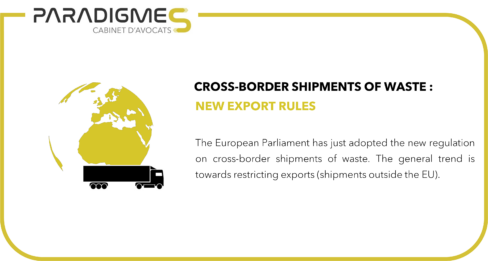
by Evguénia DEREVIANKINE | 28 Feb, 2024 | News
The result of the periodic review of the regulations on cross-border shipments of waste (Article 60 of Regulation 1013/2006), the Regulation 2024/1157 published on April 30, 2024 substantially modifies the procedures applicable to cross-border shipments. The trend is towards facilitating intra-EU shipments of waste and restricting shipments outside the EU. There are four main new features for shipments of waste outside the EU:
- Restrictions on waste exports to non-OECD countries
So far, it has been possible to send non-hazardous waste for recovery to non-OECD countries provided that the procedures under which the latter agreed to receive it (notification, information, special controls, etc.) were respected. These procedures were laid down in regulation 1418/2007. This approach will continue to apply only until May 21, 2027.
From May 21, 2027, only countries expressly authorised by the EU to receive European non-hazardous waste for recovery will be able to receive it (articles 41 to 43 of the regulation). To be able to receive European non-hazardous waste for recovery, interested countries will have to submit a specific request to the Commission, justifying:
- the strategy for managing waste generated within their territory (reasons for the lack of recoverable waste produced internally, strategies for collecting and sorting recoverable waste produced internally, impact of imports on the management of waste produced internally, etc.);
- the extent to which the waste treatment conditions employed within the country are in line with European standards;
- the country’s general legal situation and its compliance with the international conventions listed in Annex VIII of the regulation, particularly those prohibiting child labour, etc.
Applications for authorisation to receive European non-hazardous waste for recovery may be submitted from May 20, 2024 (Article 86(3)(b) of the Regulation).
Authorisations issued by the EU will materialise through the inclusion of the country in question in the list of countries benefiting from authorisation to receive European non-hazardous waste, which will be set out by the Commission in a dedicated regulation. This regulation will be regularly updated to take account of new authorisations issued or authorisations withdrawn.
Authorisation applications will have to be renewed by the countries every five years (see article 42(5) of the regulation).
- Restriction of trade in SRF
Solid recovered fuels (SRF), which until now have travelled outside the EU under the notification procedure, will no longer be able to be exported outside the EU, including to OECD countries (see Article 44(2)(f) of the Regulation), from May 21, 2026 (Article 86(2) of the Regulation).
- Restriction of trade in plastic waste
Single-material plastic waste with no more than 2% impurities, classified under code B3011, will no longer be able to travel outside the EU other than under the notification procedure, from May 21, 2026 (Articles 86(1) and 86(3)(d) of the Regulation).
Exports of such waste for recovery in non-OECD countries will be strictly prohibited from November 21, 2026 (Articles 39 and 86(3)(c) of the Regulation). However, this ban may be lifted for a certain number of non-OECD countries from May 2029, provided that countries wishing to receive this waste for recovery notify the Commission and justify that they have the capacity to treat it without danger to the environment (see Articles 40(3)(b) and 42(4) of the Regulation).
Plastic waste classified under code Y48 may only travel to OECD countries, subject to notification procedure (see Articles 4(2) and 41 of the Regulation).
- Prior audit requirement for recovery facilities outside the EU
From May 21, 2027, all waste recovery facilities located outside the EU (including in OECD and EFTA countries) will have to be audited to demonstrate that they are managed in conditions close to the Best Available Techniques (BREF) adopted by the EU in application of Directive 2010/75 on polluting emissions (see Article 46 of the Regulation and Annex X thereto).
The audit obligation will apply to facilities receiving both “green list” and “amber list” waste (including for a simple treatment test) (see article 46(3) of the regulation and its annex X).
The audit must be carried out by an accredited organisation (accreditation in accordance with EU standards or international standards such as ISO 19011:2018 or ISO/IEC 17020:2012) and will consist of a physical and documentary check of the conditions under which the facilities are operated (technologies used, infrastructure used, robustness of the processing chain, documentary traceability, etc.; see Annex X, Part B of the Regulation).
The facilities concerned will only be able to receive waste once they have received the results of such an audit.
The cost of the audit may be shared between several exporters (see Article 46(5) of the Regulation, requiring exporters to share the audits carried out subject to appropriate remuneration, with the Commission keeping a public register of the audits carried out) or it may be borne by the receiving facility. The audit will have to be repeated every two years.
The EU will also be able to conclude bilateral agreements with countries that guarantee a high level of health and environmental protection, exempting their facilities from the prior audit requirement. In any case, shipments will have to be stopped if the exporter receives reliable information indicating that a facility at destination, whether or not subject to a pre-export audit requirement, no longer meets the criteria defined in part B of Annex X of the Regulation. Shipments may only be resumed once an audit has been carried out to demonstrate that the facility is once again in compliance with the Regulation.
Finally, the exporter will have to make available to the public, by electronic means, information on how it complies with its obligation to pre-audit the foreign facilities to which it ships waste.
Changes affecting shipments of waste within the EU are covered under this link.






